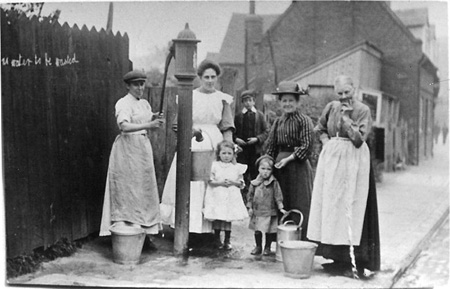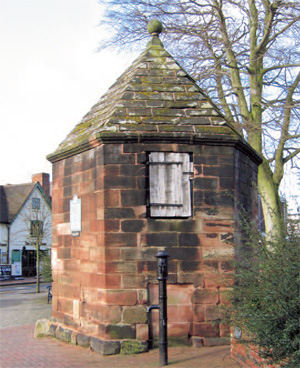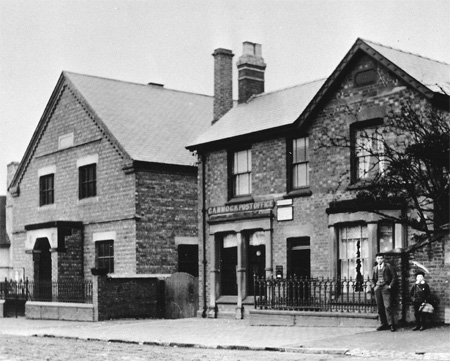In its early days as a settlement, Cannock's water
supply came from natural springs, streams and
rivers. By the early 18th century, as the town
grew, this water had become unhealthy, and in
short supply. The town needed clean water for
washing, cooking and eating.
Dr. William Byrche, who owned Leacroft Hall and The Green, one of the
most prominent houses in Cannock, assembled a group of wealthy
residents to help realise his vision of a constant supply of clean water
for the town. This led to the formation of the Conduit Trust, who funded
the construction of water pipes, or conduits, to carry water three miles
from a spring in Stringer’s Meadow to the Conduit Head here in High
Green. From the Conduit Head the water was distributed to pumps
around the town.
After the introduction of the Conduit scheme, the quality of Cannock’s
water was thought to be second only to that of Malvern, and the area’s
mortality rate became one of the lowest in the country.
In 1853 the establishment of South Staffordshire Waterworks Company
brought a new and better supply. In 1946, after suffering a combination
of problems, the Conduit supply was finally brought to an end.

The Conduit Head by J Buckler, 1841. This hexagonal building was the outlet for Cannock’s
drinking water, flowing from here to pumps situated around the town. By 1864 there were
six pumps in Cannock.
Courtesy of the Trustees of the William Salt Library, Stafford

Mill Street, just outside the town centre, was the chosen location of the second
Conduit Trust water pump. Pictured left to right are Miss Bradbury, Mrs Bertha
Stokes, Nellie Stokes, Bill Halls, Mrs Jackson with a child and Mrs Nixon.
Image reproduced by kind permission of Mrs Godwin
|

High Green in the 1920s. In 1875, Charles Foster Cotterill, who lived
at No. 95 High Green, made improvements to the town’s water
supply by replacing the Conduit’s lead and clay piping with cast iron.
He was one of the first men in the Midlands to supply water to
private dwellings and to cover the cost by introducing water rates.
Image courtesy of the Conduit Trust
 The Green The Green
Near the Conduit Head is The Green,
also known as The White House or
The
Council House. It is thought to date from
the early 1730s. Until 1735
it was
occupied by Sir Robert Fisher, and was
the first house in Cannock
to have its own
water pump.
During the early 1800s The Green became
a ladies‘ boarding school. It
changed hands
several times until it was purchased by
Cannock Urban
District Council in 1927.
The Council carried out several extensions
and
improvements, and the property was
officially opened as The Council
House on
Monday 16 January 1928.
In the 1980s The Green was acquired by
the County Council as an
extension and
offices for Cannock Chase Technical College.
|

The Conduit Head today

|
This plaque on the Conduit Head reads:
Cannock Conduit Trust founded 1736
By Public Subscription for bringing a water supply
to the Township of Cannock.
This building was erected in the year 1736 as the Conduit Head for
the water brought by pipe from Stringer’s Meadow Rumer Hill
Leacroft. The source of this water being given by Dr. William Byrche
of Leacroft Hall. The undertaking was endowed by the Lord of the
Manor the Earl of Uxbridge, the Lord Bishop of Worcester, Sir Robert
Fisher and others and later became a registered Charity and served
the Township of Cannock for over 200 years.
In 2004 a grant was awarded by the Heritage Lottery
Fund to research, renovate and resite the six original
pumps provided by the Conduit Trust. Two pumps were
found outside the district and relocated in Cannock.
Today the original locations of all six pumps are marked
by a plaque, which can be found at the following sites:
The Conduit Head, High Green
Nationwide Building Society, Market Place
Corner of Avon Road and Market Place
Attached to St Luke's Church boundary wall, The
Ringway (originally Mill Street)
Mill Street by Morrison's Supermarket
Junction of New Penkridge Road and Dartmouth Road

|
High Green was once the centre of Cannock. It is a Conservation Area – an area of special architectural or historic interest. The majority of its properties date from the 18th to early 19th century.

The bowling green has been a prominent feature of
Cannock town centre since at least 1753.
Image courtesy of the Conduit Trust
The Bowling Green
The historian Stebbing Shaw tells us that in the year 1753… the bowling green was …encompassed with a handsome brick wall. A pavilion is likely to have been built earlier, in 1752, on the side of the green opposite the existing pavilion.
The mid 1800s saw a great deal of wrangling between the bowlers and the Local Board (later to become Cannock Urban Council) over ownership of the green. In 1896 a Deed of Trust was signed by both parties to ensure the green remained a bowling green forever.
Over the years, the green has served as a social arena for events such as celebrations for Queen Victoria’s Golden Jubilee in 1877, when a group of tradesmen gathered to dine. In 1977, when he visited Cannock as part of Queen Elizabeth II’s Silver Jubilee celebrations, Prince Charles ‘bowled a wood’ on the green.
John Wood School
In 1680 Mr John Wood of London granted to certain trustees or feoffees and their heirs a house to be used and enjoyed by a school master for teaching and instructing children to read in Cannock.
Known as John Wood School after its Cannock-born founder, the original building was situated here in High Green, opposite the Bowling Green. The spot is marked by a plaque on a wall inside what is now High Green Court.
Records tell us that by 1817 some 40-60 children of pauper and the lowest classes of Cannock and nearby Cannock Wood were educated at the school each year.
In 1937, after the roof was declared unsafe, the school was temporarily transferred to a room in the New Hall. In 1939 it was found a more permanent home at a site just outside the town centre and in 2005 relocated once more.

Rosa’s, situated at 73 High Green, c1930.
Image courtesy of the Conduit Trust
P. A. Rosa and Sons
In 1900 Italian-born Peter Rosa emigrated to England with his wife. Soon after, they began to produce ice cream and sweets in the front room of their home. By the early 1920s they had set up two ice cream parlours and sweet shops – one in the neighbouring town of Hednesford, and one at no. 73 High Green.
After Mr Rosa returned to Italy in 1938 his sons took over the business. In 1952 they sold it to the Satchwells, who continued to trade using the Rosa name. The shop here in High Green finally closed in the early 1970s.
Linford’s
No. 79 High Green might be the site of one of the oldest houses in Cannock, which was a half-timbered building. The brickwork of the current building suggests it was built during the late 18th century.
In 1891 the house and gardens were sold to the entrepreneur Charles Linford. Part of the house was converted into a shop and Mr Linford began a carpentry firm, which he later expanded to become an ironmongers, glaziers and sawmill. His descendants continued the business until 1999.
The building later became a public house called the Linford Arms.

High Green c1925-30. A motor lorry stands outside
Linford’s, which continued to trade in the town until 1999.
Image courtesy of the Museum of Cannock Chase
|
Beesley’s Grocers
In 1906 the grocery store that had been established at 77 High Green was sold to Mr F.T. Beesley. Local people recall how Mr Beesley kept watch for important
customers from a glass-walled booth at the rear of the shop. He would greet the
customers he favoured and invite them into his private rooms for a glass of sherry
while their order was being prepared.
The New Hall and The Post Office
81 High Green was built in 1891 by Middlesex-born businessman J.D. Bumsted.
Known as the New Hall, it had a suite of meeting rooms and a great hall that
could seat up to 500 people, where a variety of shows and entertainment was
held. In 1892 a gymnastic display was given, and in 1914 a series of lectures
featured topics including Ancient Hunters and Lightning and Lightning Rods.
Next to the New Hall, at 83 High Green, was a post office. Built in 1908, it too
was owned by Mr Bumsted.

The Post Office in the early 1900s. New Hall, on the left was built in 1891.
Image courtesy of the Museum of Cannock Chase
The Cannock Advertiser
Known today as High Green House, no. 71 High Green was once the site of Alfred Withington’s printing business. In 1878 he launched the Cannock Advertiser, a newspaper that combined advertisements, announcements and
reports on local and national events.
When Alfred died his wife and son took over the business. The Cannock Advertiser was produced in its original form until 1985.

A view of High Green. The Cannock Advertiser offices are
close to the tree on the right.
Image courtesy of Ray Smith

|




 The Green
The Green







